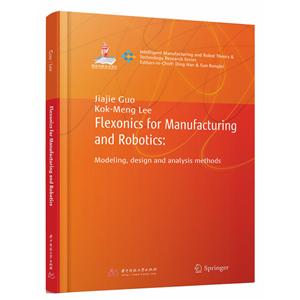预估到手价是按参与促销活动、以最优惠的购买方案计算出的价格(不含优惠券部分),仅供参考,未必等同于实际到手价。
-
>
湖南省志(1978-2002)?铁路志
-
>
公路车宝典(ZINN的公路车维修与保养秘籍)
-
>
晶体管电路设计(下)
-
>
无头案:雍正暴亡之谜
-
>
基于个性化设计策略的智能交通系统关键技术
-
>
花样百出:贵州少数民族图案填色
-
>
识木:全球220种木材图鉴
FLEXONICS FOR MANUFACTURING AND ROBOTICS:MODELING, DESIGN AN 版权信息
- ISBN:9787568040549
- 条形码:9787568040549 ; 978-7-5680-4054-9
- 装帧:一般铜版纸
- 册数:暂无
- 重量:暂无
- 所属分类:>>
FLEXONICS FOR MANUFACTURING AND ROBOTICS:MODELING, DESIGN AN 本书特色
This book formulates the large deformation of a 3-D compliant beam as a boundary value problem (BVP). Unlike other methods, such as finite element (FE) method, that formulate problems based on displacements and/or rotational angles, the BVP formulation has been derived using curvatures that are more fundamental in presenting nonlinear geometries. Since in the case of finite rotation, superposition holds for curvatures but not for rotational angles, the model is much simpler and the resulting computational process is more efficient. The above advantages have been employed in this research to analyze compliant mechanism designs using curvature-based beam models. Along with the method of deriving the compliant members in the same global reference frame, a generalized constraint acting on a compliant mechanism is presented to replace traditional boundary constraints (such as fixed, pinned or sliding constraint) where none or only one degree of freedom (DOF) is allowed. Inspired by the dexterity of a natural biological joint that offers efficient multi-axis rotation, this research extends to the modeling method of a generalized constraint (or referred to here as a bio-joint constraint) to develop designs emulating commonly observed human motions of multi-DOFs . Using a multiple shooting method (MSM), the BVP is treated as an initial value problem and higher order accuracy can be achieved than finite element (FE) methods.
FLEXONICS FOR MANUFACTURING AND ROBOTICS:MODELING, DESIGN AN 内容简介
This book formulates the large deformation of a 3-D compliant beam as a boundary value problem (BVP). Unlike other methods, such as finite element (FE) method, that formulate problems based on displacements and/or rotational angles, the BVP formulation has been derived using curvatures that are more fundamental in presenting nonlinear geometries. Since in the case of finite rotation, superposition holds for curvatures but not for rotational angles, the model is much simpler and the resulting computational process is more efficient. The above advantages have been employed in this research to analyze compliant mechanism designs using curvature-based beam models. Along with the method of deriving the compliant members in the same global reference frame, a generalized constraint acting on a compliant mechanism is presented to replace traditional boundary constraints (such as fixed, pinned or sliding constraint) where none or only one degree of freedom (DOF) is allowed. Inspired by the dexterity of a natural biological joint that offers efficient multi-axis rotation, this research extends to the modeling method of a generalized constraint (or referred to here as a bio-joint constraint) to develop designs emulating commonly observed human motions of multi-DOFs . Using a multiple shooting method (MSM), the BVP is treated as an initial value problem and higher order accuracy can be achieved than finite element (FE) methods.
FLEXONICS FOR MANUFACTURING AND ROBOTICS:MODELING, DESIGN AN 目录
FLEXONICS FOR MANUFACTURING AND ROBOTICS:MODELING, DESIGN AN 作者简介
Jiajie Guo?received the B.S. degree from the Department of Mechanics and Engineering Science at Peking University, Beijing, in 2006, and M.S. and Ph.D. degrees from Mechanical Engineering, Georgia Institute of Technology, Atlanta, in 2009 and 2011, respectively. He is currently an Associate Professor in the State Key Laboratory of Digital Manufacturing and Equipment and the School of Mechanical Science and Engineering at Huazhong University of Science and Technology, Wuhan, China. He is an IEEE and ASME member, and a program committee member of the IEEE/ASME International Conference on Advanced Intelligent Mechatronics. His current research interests include human-centered robotics, flexible mechatronics, manufacturing and system dynamics/control. He has published more than thirty peer-reviewed technical papers in journals and conferences, and has been awarded the best paper award from IEEE/ASME Transactions on Mechatronics in 2015. Kok-Meng Lee?earned his B.S. degree from the University of Buffalo, the State University of New York, Buffalo, NY, USA, in 1980, and S. M. and Ph. D. degrees from Massachusetts Institute of Technology, Cambridge, MA, USA, in 1982 and 1985, respectively. He is currently Professor of Mechanical Engineering at Georgia Institute of Technology, Atlanta, GA, USA. He is also Distinguished Professor with the State Key Laboratory of Digital Manufacturing Equipment and Technology, Huazhong University of Science and Technology, China, under Thousand Talents Plan. Prof. Lee’s research interests include system dynamics/control, robotics, automation, and mechatronics. He is a world renowned researcher with more than 30 years of research experience in magnetic field modeling and design, optimization and implementation of electromagnetic actuators. He has published over 150 peer-reviewed papers and he holds eight patents in machine vision, three degrees of freedom (DOF) spherical motor/encoder, and live-bird handling system. He is IEEE/ASME Fellow and was the Editor-in-Chief for the IEEE/ASME Transactions on Mechatronics from 2008 to 2013. Recognitions of his research contributions include the National Science Foundation (NSF) Presidential Young Investigator, Sigma Xi Junior Faculty Research, International Hall of Fame New Technology, and Kayamori Best Paper awards.?
- >
大红狗在马戏团-大红狗克里弗-助人
大红狗在马戏团-大红狗克里弗-助人
¥3.3¥10.0 - >
唐代进士录
唐代进士录
¥17.1¥39.8 - >
企鹅口袋书系列·伟大的思想20:论自然选择(英汉双语)
企鹅口袋书系列·伟大的思想20:论自然选择(英汉双语)
¥6.3¥14.0 - >
小考拉的故事-套装共3册
小考拉的故事-套装共3册
¥36.7¥68.0 - >
烟与镜
烟与镜
¥18.2¥48.0 - >
罗曼·罗兰读书随笔-精装
罗曼·罗兰读书随笔-精装
¥40.6¥58.0 - >
罗庸西南联大授课录
罗庸西南联大授课录
¥13.8¥32.0 - >
巴金-再思录
巴金-再思录
¥19.8¥46.0
-
机械设计手册 机器人与机器人装备
¥42.2¥48 -
2022图书×抽奖盲袋
¥9.9¥25 -
2023读书月阅读盲盒——天黑,闭眼,刀谁?
¥42.3¥158 -
2022读者节纪念徽章-三星会员专属
¥45¥45.6 -
2023读书月阅读盲盒——我什么场面没见过?
¥42.3¥158















